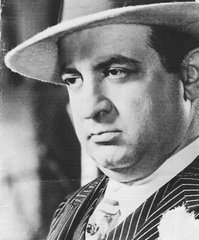You can read all about it here: http://www.blackgangstersofchicago.com/home.htm
 Ron comes with some big chops. Yeah...it's a lot of reading below, but Ron hasn't been sitting on his hands during these many years. Here are some facts straight from his bio (bold is mine):
Ron comes with some big chops. Yeah...it's a lot of reading below, but Ron hasn't been sitting on his hands during these many years. Here are some facts straight from his bio (bold is mine):"Ron Chepesiuk is a freelance journalist and film producer based in Rock Hill and Surfside Beach, South Carolina. A native of Thunder Bay, Canada, Ron worked as a Fulbright Scholar to Bangladesh in 2003 and is currently a Visiting Professor of Journalism at Chittagong University in Bangladesh. He is also an adjunct journalism instructor in the Extension Division, Journalism Department, UCLA, where he teaches courses on investigative journalism, feature writing and news writing. Ron is currently serving as an expert consultant to the History Channel's forthcoming series tentatively titled 'Gangland.'
Ron holds a B.A. degree in history and political science from Minnesota State University Moorhead, a Master’s degree in library science from Atlanta Clark University and a post graduate diploma in archival science from the National University of Ireland, University College Dublin. Prior to becoming a full-time freelance writer, he was a professor of library science at Winthrop University in Rock Hill.
Ron's latest completed media project is a co-authored book and co-produced documentary both of which are titled Superfly: The, True Untold Story of Frank Lucas, American Gangster (www.franklucasamericangangster.com). The projects examine the myths Hollywood has created about the main characters played by Denzel Washington and Russell Crowe in the recent movie, ¨Ämerican Gangster¨. For background, go to http://www.americanmafia.com/Feature_Articles_406.html) (my article) and http://www.blowbackproductions.com/blog.shtml (my interview)
The book and documentary are the first completed projects of Street Certified Entertainment LLC (http://www.streetcertifiedent.com/), a new media company Ron co-founded and co-owns. Street CertifIed will produce true crime books, films and new media products. This month, they began work on thier second project, Black Caesar: The Rise and Disappearance of Frank Matthews, Gangster Legend (http://www.blackcaesar.us/). Ron's profile of Matthews can be read at http://www.americanmafia.com/Feature_Articles_406.html, and you can view the trailer for the forthcoming documentary at http://www.youtube.com/watch?v=Da-jkbaDJV8.
In addition Ron has signed a contract to do a biography of Leslie Ike Atkinson, a major drug trafficker of the late 1960s and 1970s who pioneered the Asian heroin connection to the U.S.
In all, he has published 24 books and about 4,000 original articles in FHM, USA Today, Black Enterprise, Woman's World, Modern Maturity, The Rotarian, New York Times Syndicate, the Los Angeles Times Syndicate, Collier´s Encyclopedia, the Bulletin of Atomic Scientists, the New York Daily News and more than 400 other print publications. He also published original articles on 60 plus web sites, including americanmafia.com, Crime Magazine, the Chicagosyndicate.com, Global Politician and the New Criminologist. Given the viral nature of the Internet, his articles have been published at least 10,000 plus times. He has served a contributing editor and writer to more than 30 magazines and newspapers, including Asian Week, Rolls Royce Magazine, the Year in Computing, Irrigation and Green Industry, Crime Beat and Environmental Health Perspectives. His articles have covered every topic except gardening.
Ron's book, Drug Lords: The Rise and Fall of the Cali Cartel (Milo Books), originally publisher in hardback by Praeger Publishing as The Bullet or the Bribe, is an investigation of history's most powerful drug trafficking mafia. A new and expanded edition was published this past August. Ron's books on Black organized crime include Gangsters of Harlem: The Gritty Underworld of New York City's Most Famous Neighborhood (Barricade Books, http://www.gangstersofharlem.com/), which came out Britain as American Gangster, and Black Gangsters of Chicago (Barricade Books, http://www.blackgangstersofchicago/).
Ron is a former writing instructor in the Writer’s Digest School and has taught journalism classes at Winthrop University, Coastal Carolina University, the University of North Carolina at Charlotte and Central Piedmont Community College in Charlotte. He has also taught workshops for Investigative Reporters and Editors, the Society of Environmental Journalists and the Society of Professional Journalists and for The Daily Star, Holiday, The New Age and other newspapers in Bangladesh.
Ron has received several awards, including the OCLC-Bogle-Forrest Press Award in 1999 for “significant contribution to international librarianship,” an award from South Carolina Commission on the Status of Women in 1989 for promoting status of women in South Carolina, a 2003 DEA Watch web site Honorary Drug Enforcement Administration Agent of the Year award for his book, The Bullet or the Bribe, and several writing awards for the Florida Freelance Writers Association.
He has also received grants from the Kaltenborn Foundation to study the media in Hong Kong and Colombia, from the Fund for Investigative Journalism to study working conditions of women garment workers in South Asia, and from the South Carolina Committee for the Humanities to produce a television series on “women leaders in South Carolina for ETV (Educational Television). He is a member of Investigative Reporters and Editors, the National Writer’s Union, the International Narcotics Enforcement Officers Association and the International Association for the Study of Organized Crime.
Ron’s wife, Magdalena, is a native of Colombia, South America."




